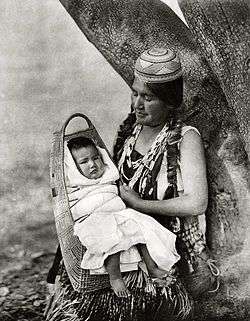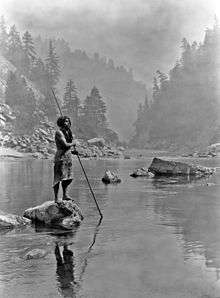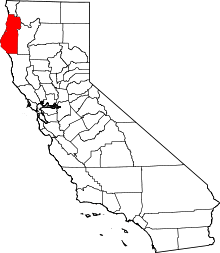Hupa
 | |
| Total population | |
|---|---|
| 3139 enrolled (2013)[1] | |
| Regions with significant populations | |
|
| |
| Languages | |
| English, Hupa | |
| Related ethnic groups | |
| Chilula and Whilkut[2] |

Hupa are a Native American people of the Athabaskan-speaking ethnolinguistic group in northwestern California. Their endonym is Natinixwe, also spelled Natinook-wa, meaning "People of the Place Where the Trails Return".[3] The majority of the tribe is enrolled in the Federally recognized Hoopa Valley Tribe.
History

The Hupa people migrated from the north into northern California around 1000 CE [2] and settled in Hoopa Valley, California (Hupa: Natinook). Their heritage language is Hupa, which is a member of the Athabaskan language family. Their land stretched from the South Fork of the Trinity River to Hoopa Valley, to the Klamath River in California. Their red cedar-planked houses, dugout canoes, basket hats, and many elements of their oral literature identify them with their northern origin; however, some of their customs, such as the use of a sweat house for ceremonies and the manufacture of acorn bread, were adopted from surrounding indigenous peoples of California.
Hupa people had limited contact with non-native peoples until the 1849 Gold Rush brought an influx of miners onto their lands.[2] In 1864, the United States government signed a treaty that recognized the Hupa tribe's sovereignty to their land. The United States called the reservation the Hoopa Valley Indian Reservation (located at 41°05′57″N 123°40′21″W / 41.09917°N 123.67250°W), where the Hupa now reside, one of very few California tribes not forced from their homeland. The reservation is next to the territory of the Yurok at the connection of the Klamath and Trinity Rivers in northeastern Humboldt County. The reservation has a land area of 141.087 square miles (365.41 km2).
-_Curtis%2C_Edward_S.%2C_1868-1952%2C_photographer_Date_Created_Published-_c1923..jpg)
Culture
Arts
Hupa people have traditionally excelled at basketry, elk horn carving, and since the 17th century, petroglyphs.[4]
Ethnobotany
The Hupa use the acorns of Notholithocarpus densiflorus to make meal, from which they would make mush, bread, biscuits, pancakes, and cakes. They also roast the acorns and eat them.[5] They also use the dyed fronds of Woodwardia radicans for basketry.[6] They also use Xerophyllum tenax to create a border pattern in baskets. [7]
Fishing
The Hupa, like many tribes in the area, fish for salmon in the Klamath and Trinity rivers. One of the methods they once used to capture fish was the fish weir, which tribal members would maintain. The Hupa share many of their fishing practices with the neighboring Yurok Tribe.[8] Hupa tribal fishers and their families rely on the Spring and Fall Chinook Salmon runs. Acorns, once abundant, were a main staple until they grew scarce. Because the Hupa were not located as close to the sea as their neighboring Yurok Tribe, they traded supplies with them, such as salt in exchange for baskets, or acorns for canoes.[9] The Hupa are involved in the talks to remove hydroelectric dams along the Klamath and Trinity rivers, and were a party to a lawsuit against the Bureau of Reclamation and the National Marine Fisheries Service. On February 8, 2017 the federal district court judge ruled in favor of the Hoopa Valley Tribe, the three other Klamath River fishing tribes, and other stakeholders. The judge agreed to plans designed by the Tribes' scientists to reduce outbreaks of a deadly fish disease that had infected 90% of juvenile salmon in 2014 and 2015.[10]
Population
Estimates for the pre-contact populations of most native groups in California have varied substantially. Alfred L. Kroeber thought that the 1770 population of the Hupa was 1,000 and that the Chilula and Whilkut accounted for another 1,000. Kroeber estimated the population of the Hupa in 1910 as 500.[11] In 1943, Sherburne F. Cook proposed an aboriginal population of 1,000 for the Hupa and 600 for the Chilula.[12] He subsequently suggested a population for the Hupa alone of 2,900.[13] William J. Wallace felt that the latter estimate was "much too high", and allowed 1,000 for the Hupa, 500–600 for the Chilula, and 500 for the Whilkut.[14] The Hoopa Valley Indian Reservation has a resident population of 2,633 persons according to the 2000 census.
See also
- Hoopa, California—the name for the town (Unincorporated community) in the Hupa Valley. The name was changed at various times related to the post office.
Notes
- ↑ "TWO RIVERS TRIBUNE ~ ONLINE - Hoopa Tribe Enrolls 22 New Members". www.tworiverstribune.com. Archived from the original on 13 September 2017. Retrieved 6 May 2018.
- 1 2 3 Pritzker 2000, p. 126.
- ↑ Pritzker & 2000xkxkx, p. 126.
- ↑ Pritzker 2000, p. 127.
- ↑ Merriam 1966, p. 200.
- ↑ Murphey 1990, p. 4.
- ↑ Murphey 1990, p. 2.
- ↑ "On the Water - Fishing for a Living, 1840-1920: The Salmon Coast". americanhistory.si.edu. Archived from the original on 2016-03-07. Retrieved 2016-02-25.
- ↑ "California Indians". factcards.califa.org. Archived from the original on 2016-05-11. Retrieved 2016-05-05.
- ↑ "Hoopa Valley Tribe Wins Court Case to Protect Salmon". Archived from the original on 2017-03-29. Retrieved 2017-03-28.
- ↑ Kroeber 1925, pp. 883.
- ↑ Cook 1976, pp. 170.
- ↑ Cook 1956, pp. 99–100.
- ↑ Wallace 1978, p. 176.
References
- Cook, Sherburne F. (1956). The Aboriginal Population of the North Coast of California. Anthropological Records. 16. Berkeley, California: University of California, Berkeley. pp. 81–130.
- Cook, Sherburne F. (1976). The Conflict between the California Indian and White Civilization. Berkeley: University of California Press.
- Goddard, Pliny Earle (1903). Life and Culture of the Hupa. University of California Publications in American Archaeology and Ethnology. 1. The University Press. pp. 1–88. Retrieved 24 August 2012.
- Kroeber, A. L. (1925). Handbook of the Indians of California. Bureau of American Ethnology Bulletin. Washington, D.C.
- Merriam, C. Hart (1966). Ethnographic Notes on California Indian Tribes. Berkeley, California: University of California Archaeological Research Facility. p. 200.
- Murphey, Edith Van Allen (1990) [1959]. Indian Uses of Native Plants. Glenwood, Illinois: Meyerbooks.
- Pritzker, Barry M. (2000). A Native American Encyclopedia: History, Culture, and Peoples. Oxford: Oxford University Press. ISBN 978-0-19-513877-1.
- Wallace, William J. (1978). Heizer, Robert F.; Sturtevant, William C., eds. Hupa, Chilula, and Whilkut. In California. Handbook of North American Indians. 8. Washington, D.C.: Smithsonian Institution. pp. 91–98.
- . Hoopa Valley Reservation: U.S. Census Bureau https://web.archive.org/web/20111223181338/http://factfinder.census.gov/servlet/DTTable?_bm=y&-context=dt&-ds_name=DEC_2000_SF1_U&-CHECK_SEARCH_RESULTS=N&-CONTEXT=dt&-mt_name=DEC_2000_SF1_U_P001&-tree_id=4001&-redoLog=false&-all_geo_types=Y&-transpose=N&-_caller=geoselect&-geo_id=28000US061490&-search_results=28000US061490&-fully_or_partially=N&-format=&-_lang=en&-show_geoid=Y. Archived from the original on December 23, 2011. Missing or empty
|title=(help)
Bibliographies
External links
| Wikimedia Commons has media related to Hupa. |
- Hoopa Valley Tribe, official website
- San Francisco State University - Hupa
